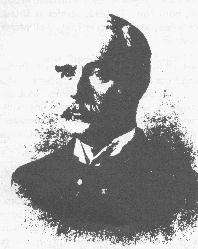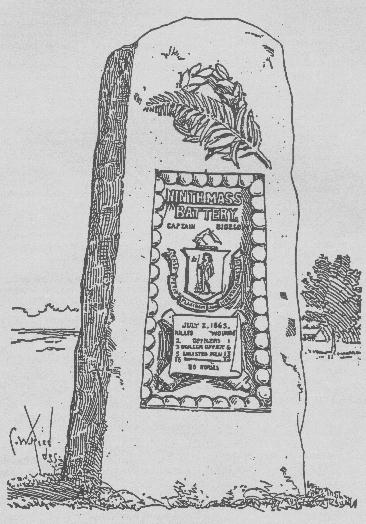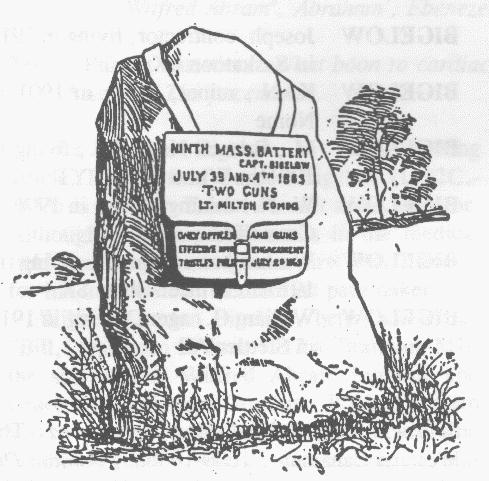
John 8 Bigelow
(16163.273) was born 4 February 1841 at Brighton, MA. He was the third
of seven children born to Samuel Bigelow, an attorney in Boston, and Anna
Jane Brooks. John was a senior at Harvard and was planning a career as a
surgeon when the Civil War broke out.
John enlisted on 24 April 1861 at Brighton as a
private with the 2nd Battery, Mass., Light Artillery. He was quickly
promoted to 2nd Lieutenant on 15 May and to 1st Lieutenant on 31 July 1861.
During the autumn of that year, he served in Baltimore and eastern Virginia.
On 16 December, he received
the appointment of adjutant in the 1st Maryland Battalion of Artillery.
He was badly wounded at the battle of Malvern Hill on 1 July 1862, where
his left arm was shattered. Rejoining the army in the autumn, he contracted
malaria at Fredericksburg and was obliged to go home, being discharged on
31 December 1862.
He was reportedly so annoyed that winter at the
comments of the papers and people on the conduct of the war, that he went
to Governor Andrew and offered his services again. A few days later, he read
in the paper the news of his appointment
to the command of the 9th Mass. Battery, Light Artillery, effective
11 February 1863. Bigelow reported that after thanking the
Governor for the confidence manifested in him, Andrew replied, "You will
find them thoroughly demoralized; they require an officer of
experience; they need discipline; your work will be difficult. If you succeed,
you shall have the fullest credit and my thanks."
The 9th Battery quickly felt the influence of the
new Captain Bigelow. He established a code of strict
discipline, and thorough inspections soon saw an increased efficiency
in camp. The men were also now treated to plenty of well-cooked food. That
winter was said to be like all Virginia winters: "some mud, some frost, more
mud, some rain, more mud, some snow, more mud - not one-fourth of the time
could [they] drill."
For almost the next two years, Bigelow led the 9th
Mass. Battery. Their most famous engagement occurred at Gettysburg the
first days of July 1863. At a critical point in the battle, the 9th was ordered
to remain in position firing non-stop while other units were moved to the
rear. Bigelow always felt his unit was sacrificed as he lost most of
his officers, half his men and all of his horses under impossible odds. Bigelow
himself was again wounded on 2 July.
Bigelow was promoted to Brevet Major on 1 August
1864. He was discharged owing to disability on 16 December 1864, with
Captain Milton replacing him as commander. The 9th Mass. Battery was mustered
out on 9 June 1865 at the close of the war.
After the war, Bigelow lived at Philadelphia where
his occupation is listed variously as machinery designer and inventor. He
married Julia Barber on 5 December 1888; they had no children.
Some 20 years after the end of the Civil War, the
Gettysburg Battlefield Association donated land at the scene of battle to
the 9th Mass. Battery for a monument site. Major Bigelow was part of
the veterans' contingent who determined the exact location of the 9th in
Trostle's field on 2 July 1863. He also was instrumental in suggesting
the general design of the monument. It was constructed from a shaft of Quincy
granite, nine feet high and three by four feet square at the base. An ammunition
chest for the rear of Trostle's field, and a stone with an ammunition haversack
cut on it for Cemetery Hill were also erected. All these monuments
are inscribed with the name of the Ninth Mass. Battery, underneath which
appears the name of Captain Bigelow.


On 19 October 1885, a party of about 175 people were on hand to mark the dedication of the monuments. Following are excerpts from the address which Major Bigelow delivered at the dedication:
"...With depleted ranks you have met today to dedicate three monuments
erected to mark the different positions where the 9th Massachusetts Battery,
to which you belonged, did heavy fighting and rendered efficient service on
this historic field of Gettysburg.
This massive granite bowlder[sic], bearing the coat-of-arms
of Massachusetts, and a table of your casualties, marks your first position.
An 'ammunition haversack' your third.
On this spot, near the famous Peach Orchard and
on the cross road leading from the Emmittsburg road to Little Round Top,
which you have marked as your first position, you received your 'baptism of
fire.'
... One thousand yards in advance of our own lines,
without infantry support or a single friendly shot from any of our batteries,
with the enemy advancing on our front and flank, 'by prolonge' you 'retired
firing' for nearly four hundred yards, until you reached your second position,
which you have marked with a monument at the angle of the stone wall which
borders this field near Trostle '5 house.
... The statistics of the War Department show, I
am told, that with the single exception of a battery which was captured by
a sudden charge at the battle of luka, you sustained heavier losses in this
engagement than any other light battery suffered in a single engagement during
the whole war.
...Comrades, your services on this field were so
important that they are imperishably a part of the history of the battle of
Gettysburg. The reputation for reliability and steadiness which you
gained here, you afterwards many times confirmed.
... I will close my remarks with an extract from
a letter written by Gen. Hunt, chief of artillery of the Army of the Potomac,
to Capt. Milton at the time of your discharge. He says: 'Amongst the organizations
serving under me, the 9th Massachusetts will be associated in my mind with
some of the hardest service of the army. Upon first joining, under Capt.
Bigelow, it went immediately into battle at Gettysburg, and bore a distinguished
part, as the reports, and its list of killed and wounded, headed by the gallant
Erickson, will prove.. .The record of its battles is made, and not less honorable
is its reputation for discipline, instruction, good conduct and the deportment
of its men and officers, under both Bigelow and yourself."'
Bigelow wrote a book about his Civil War experiences
which was published under the title, The Peach Orchards. The
title refers to a location at the battle of Gettysburg, and is in his speech
above. A copy of this book is in the Bigelow Society Library and was reviewed
in a previous Forge.
Major John Bigelow died at Minneapolis, Hennean County,
MN on 13 September 1917 at the age of 76 years.
Sources: Baker, Levi W.; History of the Ninth
Mass. Battery. Lakeview Press: South Framingham, Mass., 1888
Idea submitted by: Janis Pahnke, Chicago IL.
Related Forge articles: April 1991 (book review), July 1991.
"FORGE", Bigelow Family Genealogy, Apr 1997,Vol. 26, No. 2, page 33.for "Bigelows
of Brighton" article which straightens out the confusion between the Bigelow
and Brooks families.
Obituary of John 8 Bigelow.

